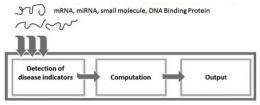July 6, 2011 feature
Biomolecular computer can autonomously sense multiple signs of disease

(PhysOrg.com) -- In the future, nano-sized computers implanted in the human body could autonomously scan for disease indicators, diagnose diseases, and control the release of the appropriate drugs. Although this scenario is still several decades away, researchers have been making significant progress in developing early types of biomolecular computers.
In a recent study published in Nano Letters, Computer Science Professor Ehud Shapiro and coauthors from the Weizmann Institute of Science in Rehovot, Israel, have developed a biomolecular computer that can autonomously sense many different types of molecules simultaneously. In the future, this sensing ability could be integrated with a vast biomedical knowledge of diseases to enable computers to decide which drugs to release.
“We envision nanometer-sized computing devices (made of biomolecules) to roam our bodies in search of diseases in their early stage,” coauthor Binyamin Gil from the Weizmann Institute of Science told PhysOrg.com. “These devices would have the ability to sense disease indicators, diagnose the disease, and treat it by administering or activating a therapeutic biomolecule. They could be delivered to the bloodstream or operate inside cells of a specific organ or tissue and be given as a preventive care.”
The development builds on the researchers’ previous demonstration of a biomolecular computer that consists of a two-state system made of biological components (DNA and a restriction enzyme). The computer, which operates in vitro, starts from the Yes state. In each computation step, the computer checks one disease indicator. If all of the indicators for the tested disease are present, the computation ends in the Yes state, namely it makes a positive diagnosis; if at least one disease indicator is not detected, it ends in the No state.
Previously, Shapiro's group showed that this biomolecular computer could detect disease indicators from mRNA expression levels and mutations. In the current study, the researchers have expanded the computer’s ability to also detect disease indicators from miRNAs, proteins, and small molecules such as ATP. At the same time, the computer’s detection method is simpler than before, requiring fewer components and fewer interactions with the disease indicators.
As the researchers explain, sensing a combination of several disease indicators is much more useful than sensing just one, since it allows for better accuracy and greater sensitivity to differences between diseases. For example, they note that in the case of thyroid cancer, the presence of the protein thyroglobulin and the hormone calcitonin can enable a much more reliable diagnosis than if only one of these disease indicators was detected.
Although the ability to detect several disease indicators marks an important step toward in vivo biomolecular computers and programmable drugs, there are still many obstacles that researchers must overcome in the process.
“The biggest challenge is operating such devices in living surrounding like the blood stream or cell's cytoplasm,” Gil said. “Currently we are developing devices that rely on simpler machinery (e.g. no restriction enzyme) or on the cell's own machinery.”
More information: Binyamin Gil, et al. “Detection of Multiple Disease Indicators by an Autonomous Biomolecular Computer.” Nano Letters DOI:10.1021/nl2015872
Copyright 2011 PhysOrg.com.
All rights reserved. This material may not be published, broadcast, rewritten or redistributed in whole or part without the express written permission of PhysOrg.com.


















